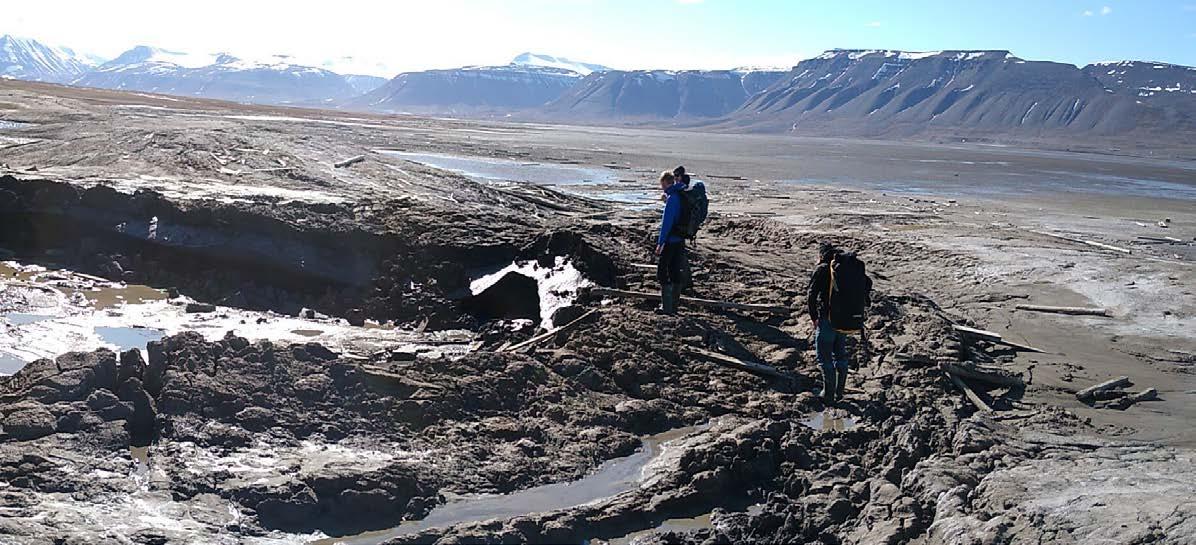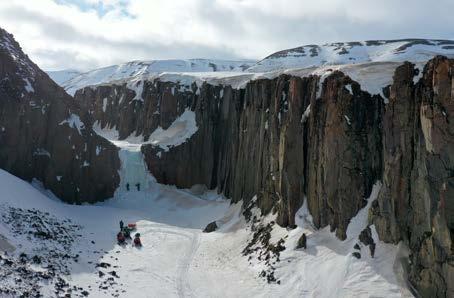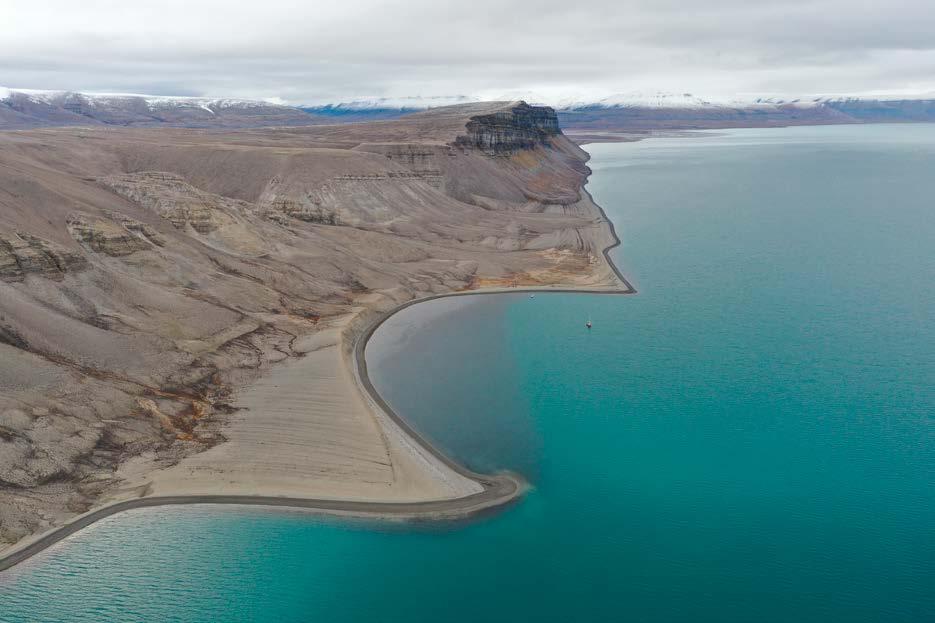
11 minute read
ARCTIC GEOLOGY
BY HANNE H. CHRISTIANSEN, HEAD OF DEPARTMENT
The Arctic Geology (AG) department’s research and education is focused on the geological evolution of Svalbard as recorded in spectacular geological sequences spanning from the Precambrian to the Cenozoic and overlain by Quaternary glacial and interglacial deposits. Easily accessible outcrops make it possible to do research in the interplay of continental drift with tectonic, glacial, periglacial, coastal, fluvial and marine sedimentary processes.
Advertisement
The close proximity of present-day geological, glacial, periglacial, marine, and terrestrial processes provides an exciting field laboratory as the basis for our research and education within three main areas: Arctic Basins, Marine and Quaternary geology, and the Cryosphere.
During 2020 the department had nine full time faculty positions, which were filled by four professors, four associate professors and one vacant position. One new PhD student and three new postdocs joined the AG in the beginning of the year. The end of 2020 also marked the end of an era as long-term Arctic Basins member Snorre Olaussen retired and left the island. Thankfully, he continues actively as ever as UNIS’ first Professor Emeritus!
EDUCATION
Due to Covid-19 only four courses were taught in our department in spring 2020, due to the cancellation of all courses from April to December. From March onwards, the majority of the Arctic Basins team ensured that the courses running at the time of the lockdown were completed through means of digital teaching. It was not easy but through a real team effort it was possible. The use of digital outcrops, openly shared through the Svalbox portal developed at UNIS, contributed greatly.
The AG department was responsible for 28 % of all student production at UNIS in 2020, despite that we only were able to actually produce around 30 % of the course student production.
A record number of guest students in 2020 was on account of scholarships offered by UNIS. We successfully increased the total number of bachelor-, master and PhD thesis research-based projects by these guest students.
The DIKU funded project A Digital Learning Environment for field-based geoscience teaching led by Maria Jensen
June 2020: The pingo in Moskuslaguna across the fjord from Longyearbyen. Photo: Eleanor Jones/UNIS.

is exploring the use of digital platforms in geology education and focus on integrating classroom and field teaching in a seamless way using Ipads and an in-classroom Smartboard. As physical teaching was cancelled for most of 2020, this project got a one-year extension to allow for working with the digital tools in practice through spring 2021.
In June 2020 the Centre for Integrated Earth System education (iEarth) was started. This is a centre of excellence in education, with the UNIS AG and AGF departments as one of four national partners in the 5-year project. We are involved in the DIKU funded multi-departmental project FieldPass led by the AB department, to further develop the field education at UNIS. The project was put on hold in 2020 due to Covid-19.
RESEARCH
The department has three specialised research groups, presented below with their different main activities. We also collaborate with other UNIS departments and partners nationally and internationally.
Arctic Basins
The Arctic Basins group had – as virtually everyone else in the world – many of its field campaigns and courses disrupted by Covid-19. The year 2020 started positively – with Aleksandra Smyrak-Sikora’s PhD defense on extensional growth basins in late February.
Two new members joined the group before the pandemic hit – Gareth Lord started as a postdoc in the Research Centre for Arctic Petroleum Exploration (ARCEx) project on shallow reservoirs, while Anders Dahlin started as a PhD candidate in the Suprabasins project. In addition, Aleksandra continued at UNIS as an ARCEx funded postdoc, contributing to the synthesis efforts of the centre, in particular with respect to Carboniferous basin development on the Barents Shelf. Peter Betlem and Kim Senger continue to build up the Svalbox database, an online portal integrating existing geoscientific material with new virtual outcrop models collected by UNIS. A new UArctic-funded project (Svalbox2020) was awarded in September 2020 – the project will run until August 2022 and constitute a major upgrade to the Svalbox portal allowing additional data sets and storylines. You can already check-out 360-degree imagery and virtual field trips at www.svalbox.no.
The summer field campaign – using a local sailboat as a base – exceeded all expectations. Covid-19 adaptions apart, PhD students and postdocs alike managed to acquire critical data in the field, from Hornsund in the south to the Billefjorden Trough in the north. We also focussed on acquiring more digital models for Svalbox and marketed this portal to both industry and partner universities. The highlight of the Svalbox-data acquisition was the digitization of the renowned Festningen profile in September – we can now access 300 million years of Svalbard’s geological evolution digitally – anytime, anywhere. This was done as an iEarth-funded internal project.
Maria Jensen was on sabbatical during 2020 and spent time developing international collaboration to develop methods to retrieve high-resolution palaeoclimate proxies from coal seams on Svalbard. Covid-19 also put constraints on this work as planned laboratory visits, talks and a visit to the US were cancelled, but contacts were developed with partners in Denmark, Canada, and the US.
Malte Jochmann was working on his PhD project compiling data from large number of coal exploration boreholes and outcrop fieldwork in the Firkanten formation at the base of the Central Tertiary Basin. This work is providing a new high-resolution 3D understanding of the basin development.
The DynaCoast project, coordinated by Maria Jensen, was completed and for the first time a detailed morphological map of the coastal zone in Isfjorden is presented. Data are made available through the Svalcoast Science HUB platform (https://svalcoast.com/). The platform will serve as a gateway to data from the MovingCoast project, where we work on establishing methods for InSAR analysis of coastal movements in the Svalbard area on a centimetre scale. Fieldwork for the MovingCoast project was carried out in the Isfjorden area, although collaborators from University of Caen, France were not able to travel to Svalbard due to the travel restrictions.

Marine and Quaternary geology
Riko Noormets’ research focussed on the geological evolution and processes of the eastern and northern Svalbard margins. New results were published on the role of oceanographic processes during the deglaciation of the Barents Sea, in collaboration with international partners. Research on glacial and climate history in previously unmapped fjords continued in the western as well as eastern Svalbard. A grant from the ASIAQ project enabled development of a prototype Multi-purpose Autonomous Surface Platform for polar marine research (MASP) that uses machine learning algorithms for acoustic seafloor mapping in collaboration with colleagues from the KTH Royal Institute of Technology and Stockholm University. Trials are planned in Svalbard for the first time in 2021. During 2020, Mark Furze’s research focused on the geomorphic and geochronological signal of regional deglaciation and sea-level changes in western Svalbard. This included leading a successful internationally collaborative field campaign on the Erdmannflya peninsula constraining rates of Holocene coastline emergence and imaging raised beaches using terrestrial laser scanning and UAV photogrammetry with colleagues from the Geological Survey of Norway and Bangor University (UK).

May 2020: Hyperittfossen in De Geerdalen. Photo: Peter Betlem/Svalbox.no.
Adjunct professor Martin Jakobsson led the work on release of a new bathymetric compilation of the Arctic Ocean (International Bathymetric Chart of the Arctic Ocean), IBCAO v4. This is an important milestone in achieving the ambitious goals of SEABED 2030 (www.seabed2030.org) of fully mapping the ocean floor globally by 2030.
During the year, several external PhD and MSc students started or continued their thesis work at UNIS on various aspects of Arctic marine, glacial, climate and environmental evolution and processes. All these students are supervised by AG staff.
The cryosphere
Members of the Cryosphere research group were involved in two new projects funded by the RCN and led by Andy Hodson: Blue Ice Oases of Microbial Life on the Antarctic Ice Sheet (BIOICE)and Climatic forcing of terrestrial methane gas escape through permafrost in Svalbard (CLIMAGAS). In the BIOICE project, the year began with the 260 km transport of six short ice cores, water samples and snow from the Norwegian Troll Station in Antarctica, across numerous crevasses to the margins of the Fimbul Ice Shelf, before shipment to the UK. These samples, collected

September 2020: Kapp Schoultz, Tempelfjorden. Photo: Svalbox.no.
by Aga Nowak and Andy Hodson, only just made it to the laboratories before they were closed for the rest of the year by the Covid-19 pandemic. Back in Svalbard, the CLIMAGAS team were mapping and sampling all perennial groundwater springs in Nordenskiöld Land, finding more than 100 sites where gas-rich water discharges even during the winter. The CLIMAGAS team later published two companion papers in The Cryosphere describing the hydrogeological and geochemical processes that make pingos in Adventdalen particularly important sites for methane emission.
The cryosphere group is also active in the Svalbard Integrated Arctic Earth Observing System (SIOS) - Infrastructure development of the Norwegian node, InfraNOR, funded by the RCN and led by Hanne H. Christiansen. This project had all its 2020 field activities put on hold due to Covid-19.
UNIS led the project Permafrost core data with ground ice information and overview of drilling equipment in Svalbard (PermaSval), funded by SIOS, updating the regional analyses of the permafrost ECV (essential climate variables) observations, and adding information about ground ice content and available permafrost drilling equipment in Svalbard into the third SESS report contribution. Hanne H. Christiansen coordinated this work with Italian, Russian, Polish, German and Norwegian partners.
Another project funded by SIOS and led by UNIS is the SvalHydro project, which compiled 50 years of longterm hydrological and hydrometeorological data from Svalbard, presenting for the first-time climate change effects upon freshwater discharge from across the island. It was discovered that catchments with rapidly receding glaciers have been producing decreasing amounts of freshwater for over a decade, while deglaciated catchments and those with large polythermal glaciers show the opposite behaviour. Aga Nowak coordinated this work with Norwegian, Polish, Russian, UK and Czech partners.
The first UNIS Strategic Pilot Project Developing a permafrost and meteorological climate change response system to build resilience in Arctic communities (PermaMeteoCommunity) was funded in December. It is coordinated by Hanne H. Christiansen, and with participation from Aleksey Shestov (AT), Marius Jonassen (AGF) and adjunct Graham Gilbert (AG) in addition to Longyearbyen Community Council, Telenor Svalbard, and the Norwegian Water Resources and Energy Directorate among the partners.
PhD student Sarah Strand worked on collecting permafrost ground thermal data and active layer observations from the UNIS monitoring infrastructure. PhD student Holt Hancock worked on research to characterize the broad-scale atmospheric circulation patterns leading to regional avalanche cycles in Nordenskiöld Land.
The department also worked on the DRIVA snow sensor project in collaboration with the Arctic Safety Centre and Telenor Svalbard to integrate data from the lowcost snow depth sensors developed in this project into
avalanche forecasting and risk management efforts both in Longyearbyen and on the Norwegian mainland.
The Cryosphere staff also supervised several external PhD students and guest master students on a range of topics including erosion studies, the Foxfonna ice cap, thermal changes in winter snow accumulation, and geochemistry of winter glacier drainage, to name a few topics. The accomplishments of these visiting students were outstanding, given the logistical constraints imposed by the pandemic.
RESEARCH ADMINISTRATION
UNIS has had the presidency (Hanne H. Christensen) and secretariat (Sarah Strand) of the International Permafrost Association (IPA) over several years, but on 1 July 2020 this function was formally handed over to Canada. Due to Covid-19 the International Conference on Permafrost, to be held in China in June, was postponed to 2022.
Kim Senger is leading the University of Arctic (uArctic) Thematic Network on Arctic Geology, a platform for circum-Arctic collaboration on outreach, education, and research efforts.
Maria Jensen participates in the Kongsfjorden flagship group under the Ny-Ålesund Science Managers Committee (NySMAC), and is involved in collaboration between terrestrial and marine biologists, geophysicists and onshore geoscientists studying land-sea transects in Kongsfjorden and the influence of long- and short-term sediment dynamics on ecosystems.
GRADUATES 2020
PHD DEGREES:
ALEKSANDRA SMYRAK-SIKORA
Development of extensional growth basins: A field-based study, Svalbard, Norway. (UNIS and the University of Bergen).
MASTER DEGREE:
ARMIN DACHAUER
Aerodynamic Roughness Length of Crevassed Tidewater Glaciers from UAV Mapping. (Swiss Federal Institute of Technology Zurich and UNIS).
JODIE ALICE SCRUPPS GELDARD
The production of a Quaternary Geological map of Endalen, Svalbard, and assessment of Holocene geomorphic processes. (University of Sheffield and UNIS).
ERIK SCHYTT HOLMLUND
Rapid temperature rise may have triggered glacier surges all over Svalbard. (UiT – The Arctic University of Norway and UNIS).
JULIAN JANOCHA
Structural and depositional evolution of the Fortet karst collapse outcrop in inner Billefjorden, Central Spitsbergen, Svalbard. (University of Potsdam and UNIS).
JACOB BERG LOFTHUS
Snow avalanches on Svalbard - Investigating changes in despositional patterns and their palaeocliamtic significance. (NTNU and UNIS).
KAROLINE HELEN LØVLIE
Structural deformation and mineralogy of the Agardhfjellet and Rurikfjellet formations in central Spitsbergen, Svalbard. (University of Oslo and UNIS).
JASPER LEONARD MAGERL
Evidence of methane release into Arctic fjords through subglacial discharge and pockmark seepage. (University of Oxford and UNIS).
LISE NAKKEN
Structural evolution of the lower Agardhfjellet Formation, in Central Spitsbergen: Implications for caprock integrity. (University of Oslo and UNIS).
CHRISTIAN FRIGAARD RASMUSSEN
High Resolution Holocene Climate and Paleoenvironmental Reconstructions from Adventdalen, Svalbard based on OSL dating of loess. (Aarhus University, Technical University of Denmark, and UNIS).
INGER MARIE FAUSA AASBERG
Paleoclimatic reconstruction from laminated lake sediments, Bødalsvatnet, Nordenskiöld Land, Svalbard. (Norwegian University of Life Sciences and UNIS).









